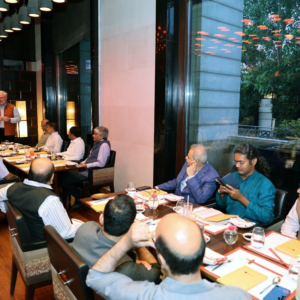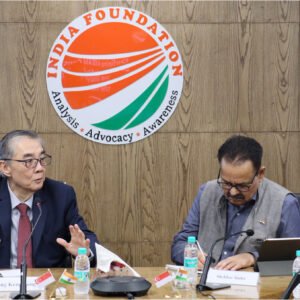~ By Sunil Raman
In the two years since assuming office Prime Minister Narendra Modi has made a decisive difference in positioning India and in addressing its security concerns. His initiative in the Indian Ocean Region is one such prominent break from the past. The disjointed and hesitant steps of the past is giving way to a more structured approach where Modi works towards translating India’s natural geographical advantage and close cultural ties with many countries in the region to position itself as the central force in the region.
Modi has promised to bolster India’s presence in the Indian Ocean Region and enhance co-operation with countries like US, Japan and Australia.
The US-India Joint Strategic Vision for Asia Pacific and Indian Ocean Region and the signing of US-India Defense Framework have signaled the determination of the two nations to join hands in maritime security.Malabar joint naval exercises started as a bilateral arrangement between US and Indian navies in 1992 where Japan used to be an invitee has now transformed into a Trilateral Forum where the three navies would conduct joint exercises alternating between Indian Ocean and the Pacific Ocean. The latest exercise was conductedoff northern Philippines, close to South China Sea where Chinaaggressively contests territorial claims of some South East Asian countries like Philippines and Vietnam.
Modi sheds inhibitions, claims India’s natural leadership position in IOR
It was Modi’s visit to Indian Ocean nations of Mauritius and Seychelles in 2015 that brought global attention to change in strategy by New Delhi when he shared, in the words of strategic affairs expert C Raja Mohan, “India’s master plan for Indian Ocean Region”.
Charting out India’s cultural footprint across Asia and Africa Modi said India must also assume “our responsibility to shape its future” and declared Indian Ocean Region to be at the “top of our policy priorities”.
He then spelt out the five-point vision for IOR:
- India will do everything to safeguard our mainland and islands and defend our interests. To ensure a safe, secure and stable Indian Ocean Region that delivers us all to the shores of prosperity.
- To deepen our economic and security cooperation with our friends in the region especially our maritime neighbours and island states. We will also continue to build their maritime security capacities and their economic strength.
- Collective action and cooperation will best advance peace and security in our maritime region. It will also prepare us better to respond to emergencies.
- We also seek a more integrated and cooperative future in the region that enhances the prospects for sustainable development for all.
- Those who live in this region have the primary responsibility for peace, stability and prosperity in the Indian Ocean.
Initiatives that seek to revive cultural links and help build sustainable economies among littoral states, Project Mausam and SAGAR, were launched with clear strategic vision.
The Modi government had been pushing cultural and military diplomacy as a tool for deepening strategic partnerships in the Indian Ocean region. These include joint exercises, hydrographic surveys, equipment transfer, joint training, and access to military academies in India among others.
From visiting Pacific islands to Indian Ocean littorals, and a recent trip to East African countries prime minister Modi has made a determined bid to reconnect with countries, some of which have been part of India’s cultural sphere of influence and look upon India to take the lead.
Promised projects that remained caught in bureaucratic files in New Delhi were dusted out and the Modi government has committed to help Seychelles develop infrastructure on Assumption Island, and to speed up development of Agalega Island in Mauritius.
Trips to Mozambique, South Africa, Tanzania and Kenya in June 2016 were to widen maritime security partnership.
For years India has been slow or indifferent in its response to many countries in Asia and Africa who eagerly looked up to New Delhi to use its growing economic muscle and historic links with them to assist in neutralizing China’s growing footprint in the region. That lethargy has given way to greater determination to lead from the front in securing waters while helping strengthen economies of IOR nations.
Few months ago the new version of Indian Maritime Doctrine was released to coincide with the International Fleet Review 2016. This document has enlarged India’s areas of maritime interest to south-east and westwards of Indian Ocean. It states that with growing economic and military strength of the country, the national security imperatives and political interests stretch “beyond the Indian Ocean Region.”
Change in tack was emphasized by the then Naval Chief Admiral RK Dhowan in the strategy document when he observed that “there seems little doubt today that the 21st century will be the ‘Century of the Seas’ for India and that the seas will remain a key enabler in her global resurgence”.
Importance of Indian Ocean
Unlike the Pacific and Atlantic Oceans, the Indian Ocean is not just open waters but is bound by land on the East, West and North. Instead enclosed within a land mass on all sides, it has kept people and civilizations that came up on the contiguous land masses, in perpetual contact. India, by its sheer geographical location and size, lent its name to these waters that saw Indian kings of the ancient world transfer considerable ideological and religious influence to countries in South East Asia.
These waters were never owned by any kingdom or country. No country, including India, in spite of its dominating presence, ever claimed ownership of these waters. The Indian Ocean has been “a great highway… a wide common”, in the words of the great naval historian, Alfred Thayer Mahan in ‘The Influence of Sea Power upon History’.
The Indian Ocean connects three continents – Asia, Africa, Australia and the Antarctica. It is home to one-third of the world’s population, also being the largest market for consumer goods, with two-thirds of proven oil reserves, one-third of world’s natural gas, 90 per cent of world’s diamonds, 60 per cent of world’s uranium and 40 per cent of world’s gold reserves.Its waters constitute the lifeline with one-half of world’s crude oil container shipment and one-third of bulk cargo passing through.
It is also home to world oil transit chokepoints. Bound by land on three sides maritime access for tankers and cargo vessels transporting oil and other cargo from one part of the world to the other is through narrow gateways or narrow sea lanes. Free and unhindered passage through these sea routes is essential for global energy flows. Closure of these narrow gateways or choke points can disrupt the flow of oil and gas leading to a devastating impact on global economy and security. Unlike other oceans 80 per cent of total trade in Indian Ocean is extra-regional and only 20 per cent trade between littoral states.
These waters connect four major land bodies-Africa, Asia, Australia and Antarctica. Thirty-five countries, including six island nations, are Indian Ocean Rim states or littoral states and “40 per cent of the world’s seaborne crude oil supplies and 50 per cent of the world’s merchant fleet”depend upon the security of these waters. Crude oil from the Persian Gulf destined for South Asia, South East Asia and the Far East passes through its waters. Apart from “principal oil shipping lanes” the “main navigational choke points of world commerce” – the Straits of Bab el Mandeb, Hormuz and Malacca – are located in the Indian Ocean. There are others like the Suez Canal, Cape of Good Hope, Sunda Strait, Lombok Strait, Ombai and Wetar Straits.
Critical choke points
- Bab el Mandab-Between the Horn of Africa and the Middle East, a strategic link between Mediterranean Sea and Indian Ocean. Located between Yemen, Djibouti and Eritrea it is 18 miles wide at its narrowest point and makes tanker traffic difficult.
- Strait of Hormuz-World’s most important oil chokepoint in the Persian Gulf through which more than 85 per cent of crude oil exports to markets of Japan, India, China and South Korea. With Iran to its north the Strait of Hormuz is 21 miles at the narrowest part.
- Straits of Malacca-Links the Indian Ocean to the Pacific Ocean and provides the shortest sea route between Middle East and the growing Asian markets. Located between Indonesia, Malaysia and Singapore, it links the Indian Ocean to South China Sea and Pacific Ocean. It is 1.7 miles at its narrowest point and remains a crucial chokepoint. But, its importance emerges from over 60,000 ships that transit the Straits annually carrying a quarter of world trade.
The Indian Ocean Region is also home to some of the most unstable countries like Somalia and Yemen, radical Islamic outfits, terror groups and small island nations that are threatened by climate change.
The growing military presence of various stakeholders poses a grave threat to the region’s stability, as any untoward incident has the potential to create a major disruption in cargo traffic and movement of energy supplies
World Map sidelines Indian Ocean Region
Geography, however, has been at the mercy of global politics with a “bias against the Indian Ocean” established from the time of the European domination of the world, through the Cold War years, and until recently. The world map made by Gerardius Mercator fourcenturies ago and in use even today reinforces the prejudice against this region with the western hemisphere located at the center of the map and the Indian Ocean split on the edges of the map. Such a map has kept attention focused on the western hemisphere.
Author is a former BBC journalis, now head Public Affairs in India for Hill & Knowlton Strategies. His post-graduate thesis at the Fletcher School of Law & Diplomacy was on “Building a Collaborative Security Architecture in the Indian Ocean Region”
(This article appeared in India Foundation Journal, July-August 2016 issue.)



